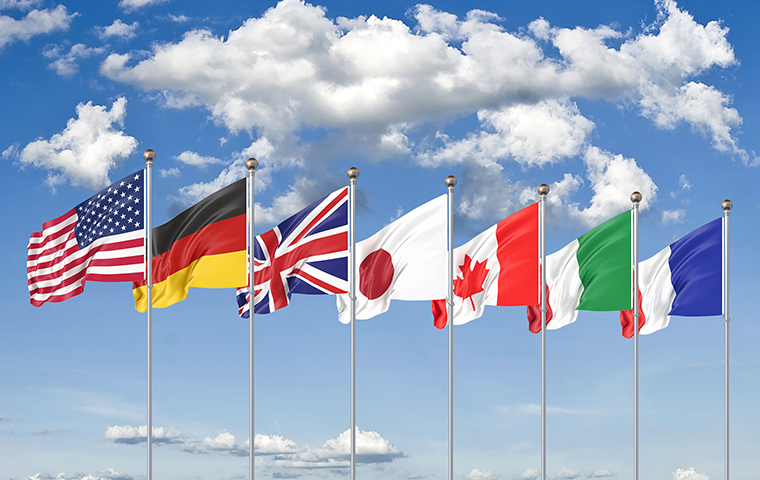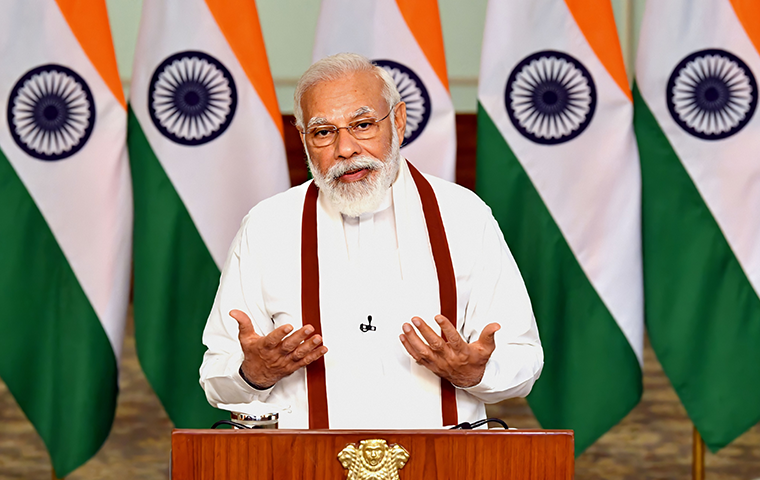Approaching China: Europe Takes a Softer Stance Than the U.S.
Related Articles

As it always has been, the G7 has mounting issues to discuss. At the Hiroshima Summit, held in May 2023, besides the Leaders’ Communiqué, five outcome documents were issued: Support for Ukraine, Nuclear Disarmament, Economic Security, Clean Energy, and Food Security. Within these broad themes lies entangled sets of issues involving specific entities and agendas, such as Russia, China, artificial intelligence, financial system stability, the Global South, climate and energy, health and hygiene, and food crisis. And as the matter of fact, the member states have differing levels of sensitivity toward these sets of common challenges.
How to Support Ukraine
As two political scientists said, the summit is a place where “a parallelogram of forces” emerges (Hanging Together: The Seven-Power Summits. By Robert Putnam and Nicholas Bayne),” where different domestic and international dynamics operate side by side. So, the member states apparently have their own motives. Even among the G7, the distance and sense of urgency toward actors and agendas cited above, are not equal. For the heads of states—especially as they are democratic countries—a summit is where they appeal the country’s diplomatic legitimacy to public minds at home and abroad. Moreover, the leaders of Germany, France, and other G7 nations face poor approval ratings. Though rather oversimplified, we can summarize the situation like this: the U.S. is focusing on securing supremacy against China in the Asia-Pacific region, the world’s growth center, while the Europeans are interested in how to end the war in Ukraine, unfolding before their eyes.
For the U.S., the G7 is an opportunity to cement Western solidarity against Russia and China. For European countries, it is a place for presenting alternatives to the U.S. global strategy. And as for Japan, which assumes the G7 presidency, it was a chance to request member states for further commitment to the security in the Asia-Pacific and to try to activate its initiative on the global stage as the only A-bombed nation, as symbolized by the Hiroshima Vision. This time, the meeting was joined by Ukraine, seeking to draw further support from the advanced nations.
As reported by the New York Times senior correspondent on security issues, U.S. President Biden was initially against providing Ukraine with F-16 fighter jets (May 17, 2023 digital edition). However, with Zelensky’s earlier visit to Europe, the U.K. and France have agreed to provide training for fighter jet pilots, which left the U.S. with fewer options.
Then, what were the stances of the U.K. and France? According to the Guardian (May 18), British Prime Minister Rishi Sunak was most concerned about countermeasures against Russian and Chinese economic coercion. Meanwhile, France was more focused on the exit strategy for the war in Ukraine and was even seeking to hold a summit for cease-fire negotiations (Le Monde, April 21).
The Global South Taking Center Stage

While each member state had their own strategy for the summit, in fact, it was those invited from the so-called “Global South” that took center stage. Unless countries like India, Indonesia, Vietnam, and Brazil are involved, even the G7 could not take effective measures against Russia and China. As everyone knows, the G7’s presence in the world has been declining over the years. Compared to 1975, their global GDP share has dropped from 60 percent to 45 percent, the population dropped from 15 percent to 10 percent, and the military spending is down from 60 percent to 50 percent. When India’s GDP is added to the total of China and Russia, it would exceed the GDP of Japan and the U.S. combined, and the BRICS’ GDP is almost 60 percent of the G7 total.
When considering Global South relations, the “values-based diplomacy” such as the schema of “democracy vs. autocracy” that Biden has advocated since the start of the administration does not sit well. If Washington brandishes “the can-do spirit of the world’s democracies” (National Security Advisor Jake Sullivan) like it did at the March 2021 U.S.-China meeting in Alaska (Recall that Chinese Communist Party Politburo member Yang Jiechi retorted, “The United States has its United States-style democracy and China has Chinese-style democracy”), it will not win the support of countries with flawed democracy. In other words, highlighting the rule of law, a “state” as the theme instead of democracy as a “value,” was the result of working backwards to find a common ground with the Global South—just like Japan chose “the rule of law” for the open debate theme as the President of the UN Security Council.
It is interesting to compare this point between the Leaders’ Communiqué from last year’s Elmau Summit and the one from the latest Hiroshima Summit. In the previous summit’s Communiqué, the word “democracy/democratic” appeared 23 times, while the “rule of law/UN Charter” appeared five times. This time, “democracy/democratic” was mentioned only 18 times, while “rule of law/UN Charter” was used 11 times. This demonstrates that the G7 had to play the part of “the guardian of the post-war order (liberal international order)” by involving the Global South, instead of being the “advanced democracies” against China and Russia that challenged the existing order.
Regarding China, the latest communiqué states, “We are not decoupling or turning inwards. At the same time, we recognize that economic resilience requires de-risking and diversifying. We will take steps, individually and collectively, to invest in our own economic vibrancy,” showing economic reconciliation, while also requesting China “to press Russia to stop its military aggression, and immediately, completely and unconditionally withdraw its troops from Ukraine.” This proves that global politics is no longer feasible without involving China. Similarly, it is difficult to have effective relations with Russia and China without the cooperation of India, another invitee to the summit. Meaning that if the G7 stays hostile to China, the Global South would be reluctant to cooperate.
It was perhaps Henry Kissinger who said that “big stick and preaching” was the basic nature of American diplomacy. But international order can no longer be maintained with these two tools. In contrast, France and Germany that fall behind the U.S. in military power, aim for “cooperation and stability.” Le Figaro reported that, according to presidential sources, French President Emmanuel Macron was strongly opposed to the decoupling strategy led by the U.S. It is undeniable that Germany and the EU chimed in. Macron, on arriving in Hiroshima, did not forget to stress that this G7 will not be a G7 of confrontation, but a G7 of cooperation and requests for China.
Can the G7 Pursue Benefits beyond Its Framework?
After the July 1975 Helsinki Accords (Conference on Security and Cooperation in Europe: CSCE) meeting that brought on the Détente, leaders and foreign ministers from the U.S., the U.K., France, and West Germany agreed on holding the first summit. The major concerns for the Western powers were the collapse of the Bretton Woods system (Nixon Shock) and stagflation triggered by the oil crisis. The G7, joined by Canada, Italy, and Japan, began as a leaders’ forum for casual exchange of views, mainly on economic issues. When U.S. President Jimmy Carter took office in 1977, G7 became more institutionalized and shifted to a framework for the unity of the advanced nations, as symbolized by the introduction of Sherpa roles. As Harold Nicholson stated, “from old diplomacy to new diplomacy,” in the early twentieth century, the G7 Summit changed from a European diplomacy of cooperation to an American diplomacy of serving its hegemony.
With the war in Ukraine, the role of the G7 is back in the spotlight. But it can no longer be just a group consisting of the world’s political and economic superpowers. The G7 is forced to transform into an issue-solving entity that will maintain the postwar order (“respecting the UN Charter” in the communiqué) it has created and benefited from, by flexibly balancing China and the Global South. Though paradoxical, how effective this will be depends on how far it can generate benefits beyond the G7 framework—namely, the interests of humanity. Yet, this is a challenging goal, especially for democratic countries.
“In the past, we only grasped the world from our perspective. The light was emitted from us, and the rest of the world was hidden in the shadows. But now, the light is simultaneously emitted from various places like Brazil, Malaysia, the Philippines, and Indonesia. Therefore, today, we are seeing a different world, of a different age.” These are the words of former French President Valéry Giscard d’Estaing, from the time when he led the first summit. Without doubt, the Hiroshima Summit at least opened a window into this “different world.”
This is a translation of the Japanese article published in vol. 79 (May/Jun. 2023) of the Gaiko (Diplomacy) magazine.
Toru Yoshida is a professor at Doshisha University. Earning a Ph.D. from the University of Tokyo in 2005, he specializes in comparative politics. His previous careers include a professor at Hokkaido University. He is the author of “Populism in Japan: Actors or Institutions?” In Alan Scott et al. (eds.) Routledge Handbook of Populism in the Asia Pacific,2023; «Populism Made in Japan: A new species?» in Asian Journal of Comparative Politics, 4(3) 2019, «L’Alternance de 2009 au Japon : La Mutation d’un Régime de parti dominant ?» in Philippe Aldrin, Luci Bargel, Nicolas Bue, Christine Pina (eds.) Politiques de l’Alternance : Sociologie des Changements de politiques, Ed. du Croquant, 2016.




